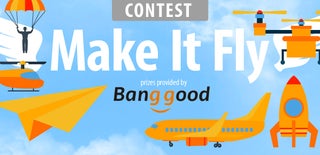Introduction: Summer Camp Ideas
Before creating our next Instructable, we thought it be important to look at a quick history of Flight.
The earliest we could find about flight is Icarus and Daedalus around 1000 BC. Daedalus a brilliant engineer built the elaborate labyrinth for King Minos. Once the labyrinth was built the King imprisoned Daedalus and his son Icarus. The king wanted to make sure none of the secrets to the labyrinth were reviled but the king also needed Daedalus alive to help with all the secrets of the labyrinth. After many years of imprisonment, Daedalus and Icarus were able to escape by making a set of wings from feathers and wax. Although Icarus was warned not to fly to close to the sun he’d melt the wax and not to low to the ocean that he’d get the feathers wet, he forgot in the excitement of flight. Icarus’s wings fell apart and he fell into the ocean.
In China around 400 BC the discovery of the kite that could fly in the air by the Chinese continued humans thinking about flying. Originally used for religious ceremonies the Chinese kite became more an more sophisticated. Eventually the kites were used to test weather conditions. Kites have been an important step to flight as many of the later inventions used the information collected from kites to understand flight.
Leonardo da Vinci made the first real studies of flight in the 1480s Over 100 Drawings illustrating his theories of flight including parachutes, helicopters and other flying machines. About 1485 he drew detailed plans for a human-powered ornithopter (a wing-flapping device intended to fly). For several hundred years his ornithopter was the inspiration for many interested in human flight.
Joseph and Jacques Montgolfier developed the First Hot Air Balloon in 1783. The brothers used the smoke from a fire to blow hot air into a silk bag. The silk bag was attached to a basket. The hot air then rose and allowed the balloon to be lighter-than-air. In 1783, the first passengers in the colorful balloon were a sheep, rooster and duck. It climbed to a height of about 6,000 feet and traveled more than 1 mile. After this first success, the brothers began to send men up in balloons. The first manned flight was on November 21, 1783, the passengers were Jean-Francois Pilatre de Rozier and Francois Laurent.
From 1799 - 1850's George Cayley worked to discover a way that man could fly. He designed many different versions of gliders that used the movements of the body to control. Over 50 years he made improvements to the gliders. He changed the shape of the wings so that the air would flow over the wings correctly. He designed a tail for the gliders to help with the stability. He tried a biplane design to add strength to the glider. He also recognized that there wouldbe a need for power if the flight was to be in the air for a long time.
In 1891 German engineer, Otto Lilienthal, studied aerodynamics and worked to design a glider that would fly. He was the first person to design a glider that could fly a person and was able to fly long distances. He was fascinated by the idea of flight. Based on his studies of birds and how they fly, he wrote a book on aerodynamics that was published in 1889 and this text was used by the Wright Brothers as the basis for their
designs. After more than 2500 flights, he was killed when he lost control because of a sudden strong wind and crashed into the ground.
Orville and Wilbur Wright test the First Airplane in 1903. Orville and Wilbur Wright were very deliberate in their quest for flight. First, they read about all the early developments of flight. They decided to make "a small contribution" to the study of flight control by twisting their wings in flight. Then they began to test their ideas with a kite. They learned about how the wind would help with the flight and how it could affect the surfaces once up in the air. The next step was to test the shapes of gliders much like George Cayley did when he was testing the many different shapes that would fly. They spent three years testing and learning about how gliders could be controlled at Kitty Hawk, North Carolina. They designed and used a wind tunnel to test the shapes of the wings and the tails of the gliders. In 1902, with a perfected glider shape, they turned their attention to how to create a propulsion system that would create the thrust needed to fly. The early engine that they designed generated almost 12 horsepower.
The "Flyer" lifted from level ground to the north of Big Kill Devil Hill, North Carolina, at 10:35 a.m., on December 17, 1903. Orville piloted the plane which weighed about six hundred pounds. The first heavier-than-air flight traveled one hundred twenty feet in twelve seconds. The two brothers took turns flying that day with the fourth and last flight covering 850 feet in 59 seconds. But the Flyer was unstable and very hard to control.
The brothers returned to Dayton, Ohio, where they worked for two more years perfecting their design. Finally, on October 5, 1905, Wilbur piloted the Flyer III for 39 minutes and about 24 miles of circles around Huffman Prairie. He flew the first practical airplane until it ran out of gas.
Humankind was now able to fly!
More details can be found on NASA's website.
Step 1: Bernoulli
Not mentioned in our quick history of flight is Bernoulli's Principal. This principal is a very important part of flight and should be learned to have a basic understanding of the science behind heavier than human flight.
"Bernoulli's Principle - the statement that an increase in the speed of a fluid produces a decrease in pressure and a decrease in the speed produces an increase in pressure" according to the Webster Dictionary.
Read more at http://www.yourdictionary.com/bernoulli-s-princip...
But we don't have to make it so complex to understand. The air flowing faster has low pressure and the slower air has a high pressure. Just kept that in mind as you go to the demonstrations.
All the kids shown were from 7 to 10 years old and attended a science camp at Trinity Lutheran Church Delta Ohio. At the end of the demonstrations they completely understood Bernoulli's Principal.
Step 2: Demonstration 1
Now that we all know a little more about flight and Bernoulli's Principal, let's have some fun!
Hold two ping pong balls from a string (or hold up with clay and straws like in our picture), at the same height, and about an inch apart (adjust as needed). Blow directly between the ping pong balls. The spheres will move together. Blowing between the spheres causes an area of lower air pressure. The other sides of the spheres now have higher air pressure in comparison and pushes the spheres together. Bernoulli's Principal is demonstrated.
Step 3: Demonstration 2
Take a hair dryer, plug it in, set to cool temperature, point toward ceiling, and turn on. Carefully set a ping pong ball into the stream of air. The ball will float in the stream of air. Now carefully move the hair dryer to angle it slightly so it appears the ball is floating over nothing. The stream of air is at a low pressure while the air in the room is high pressure comparatively. The air in the room pushes on the ball and keeps it floating even when the ball is not directly under the hair dryer.
Step 4: Demonstration 3
Take a ping pong ball and put it in to a funnel. Tip the funnel upside down while carefully holding the ball in place. Blow into the upside down funnel (spout end) as hard as you can while letting go of the ball. Try to blow as long as you can (be careful to NOT get light headed). The ball will not fall out of the funnel for as long as you are blowing! Bernoulli strikes again!! The air that is being blown over the ball is creating an area of low pressure and the air in the room is at a high pressure. The high pressure air presses on the ball and keeps it in the funnel.
Step 5: Demonstration 4
Using a industrial strength fan, adult supervision, and a few beach balls, kids can have a great time playing with Bernoulli's Principal. Simply turn fan on and carefully set the ball into the air stream. The ball will stay floating over the fan. Try gently tapping the ball to move it. You should find that it want to come back. Try two or three beach balls. Try different size beach balls. Try spheres of different masses. DO NOT use anything that can go into the fan.
The air that is being blown over the ball is creating an area of low pressure and the air in the room is at a high pressure. The high pressure air presses on the ball and keeps it floating.
Step 6: Demonstration 5
This is crowd favorite and fun to do. Using a shop vac or leaf blower with a roll of toilet paper on a piece of pvc pipe we once again demonstrate Bernoulli's Principal.
Plug shop vac in, put the toilet paper roll onto pipe, turn vac on making sure it is blowing air and not pulling air in. Holding the end of the shop vac tube in one hand and the pipe with the toilet paper in the other hand, blow the air over the top of the toilet paper. Try to get the toilet paper to fly as far as you can. Fat Cat can get the back row of his classroom with an electrical leaf blower.
The air that is being blown over the toilet paper is creating an area of low pressure and the air in the room is at a high pressure. The high pressure air presses on the bottom of the paper and causes it to lift.
Step 7: More?
There are plenty of examples and great explanations these are just a few of the ones Crazy Cat and Fat Cat use in their classrooms and at our camps.
When playing with Bernoulli's Principal we are learning. Never stop playing!!

Participated in the
Beyond the Comfort Zone Contest

Participated in the
DIY Summer Camp Challenge

Participated in the
Make It Fly Contest 2016











